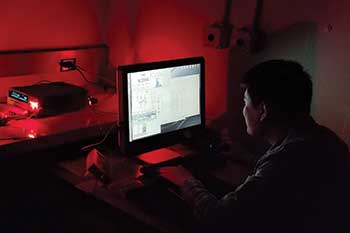Creative problem solving has always been a raison d’être for the Polytechnic. Polytechnic students and their instructors thrive on devising better ways to accomplish tasks and improve people’s lives. So when Purdue University’s “150 Years of Giant Leaps” campaign invited colleges to submit their brightest ideas in four categories of accomplishments, the Polytechnic rose to the occasion, with two patents from professors.
Giant Leaps in Health, Longevity and Quality of Life
Polytechnic professor patents better body weight support device for gait rehabilitation
The physical act of walking is often taken for granted unless someone has suffered a stroke or traumatic injury. Something that was once effortless to the brain becomes a physical challenge that the body needs to relearn. To complicate matters, patients who have suffered trauma to the body might not have the physical strength in their arms or legs necessary to hold themselves upright – let alone propel themselves forward – during their physical rehabilitation.
Hundreds of thousands of people in the U.S. depend on gait-targeted physical therapy every year. Stroke – the leading cause of long-term disability in the country – accounts for nearly 800,000 of those patients annually, according to the American Stroke Association. Physical therapists who specialize in gait rehabilitation use various types of body weight support (BWS) devices to help their patients hold themselves upright during rehab.
Xiumin Diao, assistant professor of engineering technology, is using his expertise in robotics to improve patient gait rehab. Diao and his research team created and patented a cable-driven BWS system that better supports patients while they undergo gait training during physical therapy. Their system uses thin, strong cables attached to a manipulator that secures around the patient like a parachute harness. The system compensates for body weight as patients retrain their legs for proper walking. In addition to better supporting patients, the system also is less expensive and easier to assemble and disassemble, compared to other BWS systems being used by physical therapists.
giant leaps to a sustainable world
No more batteries? Harvesting power from ambient light
Replacing ordinary objects with their “smart” alternatives might be handy. After all, wouldn’t it be nice to ask Siri to locate your misplaced car keys? However, smart key chains and other technology-embedded devices revert to being “dumb” the moment their batteries run dry, keeping them from connecting to and communicating with a household’s Internet of Things (IoT).
 What if such devices could harvest energy and transmit data using only ambient light? Daniel Leon-Salas, associate professor of engineering technology, and his research team devised a method to do exactly that. The technology they developed uses solar cells as optical antennas to transmit and receive information wirelessly between IoT devices using only light. The cells can even harvest energy from ambient light.
What if such devices could harvest energy and transmit data using only ambient light? Daniel Leon-Salas, associate professor of engineering technology, and his research team devised a method to do exactly that. The technology they developed uses solar cells as optical antennas to transmit and receive information wirelessly between IoT devices using only light. The cells can even harvest energy from ambient light.
“We created a revolutionary way to use light to power these devices,” said Leon-Salas. “Light energy is the most available form of ambient energy, with much higher energy density levels than radio-frequency or mechanical ambient energy sources.”
The research team worked with Purdue’s Office of Technology Commercialization to secure a patent for the technology. It is available for licensing.

